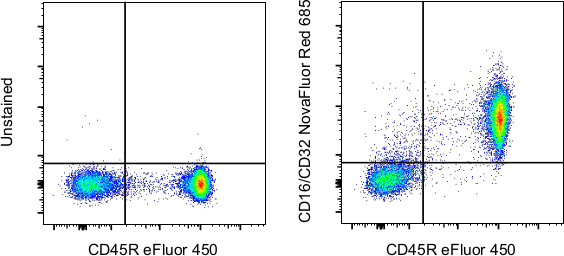Search Thermo Fisher Scientific
图: 1 / 2
CD16/CD32 Antibody (M021T02R02-A) in Flow


产品信息
M021T02R02-A
种属反应
宿主/亚型
分类
类型
克隆号
偶联物
激发/发射光谱
形式
浓度
纯化类型
保存液
内含物
保存条件
RRID
产品详细信息
Description: The 93 monoclonal antibody reacts with an epitope shared by mouse CD16 and CD32. CD16 (Fc gamma III Receptor) and CD32 (Fc gamma II Receptor) are the low affinity receptors for the mouse IgG Fc portion and are expressed by B cells, monocyte/macrophages, NK cells, and neutrophils.
Each product contains 1 vial of NovaFluor conjugate and 1 vial of CellBlox Plus Blocking Buffer .
Applications Reported: This 93 antibody has been reported for use in flow cytometric analysis.
Applications Tested: This 93 antibody has been tested by flow cytometric analysis of mouse splenocytes. This can be used at less than or equal to 1.0 µg per test. A test is defined as the amount (µg) of antibody that will stain a cell sample in a final volume of 100 µL. Cell number should be determined empirically but can range from 10^5 to 10^8 cells/test. It is recommended that the antibody be carefully titrated for optimal performance in the assay of interest.
NovaFluor dyes are not compatible with DNA intercalating viability dyes. Do not use viability dyes such as propidium iodide, 7-actinomycin D (7-AAD) and DAPI. Invitrogen LIVE/DEAD Fixable Dead Cell stains are recommended for use with NovaFluor dyes.
This NovaFluor conjugate has been updated to ship with CellBlox Plus Blocking Buffer (Cat. No. (C001T06F01)). This buffer contains formulation improvements over CellBlox. CellBlox Plus Blocking Buffer is required for optimal staining with NovaFluor conjugates and should be used in all experiments where NovaFluor conjugates are used. Whenever possible, we recommend adding CellBlox Plus Blocking Buffer to antibody cocktails/master mixes prior to combining with cells. Add 5 µL per sample (regardless of the number of NovaFluors in your panel) to use the antibody cocktail as intended. For single-color controls, use 5 µL of CellBlox Blocking Buffer per 100 µL of cell sample containing 10^3 to 10^8 cells.
NovaFluor conjugates are based on Phiton™ technology utilizing novel nucleic acid dye structures that allow for engineered fluorescent signatures with consideration for spillover and spread impacts. Learn more
Excitation: 637 nm; Emission: 685 nm; Laser: 633-640 nm (Red) Laser
靶标信息
CD16 is a 50-65 kDa cell surface molecule that exists in two forms - a transmembranous form expressed by natural killer (NK) cells, and some T cells and a phosphatidylinositol linked form expressed by granulocytes. CD16 is a low affinity receptor for IgG (FcR III), and is an important receptor mediating ADCC (antibody dependent cell mediated cytotoxicity) by NK cells. IN comparison, CD32 is a 40 kD glycoprotein that acts as a low affinity receptor for IgG (also known as Fc gamma RII), and mediates several functions including endocytosis, activation of secretion, cytotoxicity and immunomodulation. CD32 is expressed by B cells, monocytes, granulocytes and platelets. Further, CD32 is involved in the phagocytosis of immune complexes, the regulation of antibody production by B-cells, and variations of the CD32 gene may increase vulnerability to systemic lupus erythematosus (SLE). Several transcript variants encoding different isoforms of CD32 have been found.
仅用于科研。不用于诊断过程。未经明确授权不得转售。
How to use the Panel Builder
Watch the video to learn how to use the Invitrogen Flow Cytometry Panel Builder to build your next flow cytometry panel in 5 easy steps.
篇参考文献 (0)
生物信息学
蛋白别名: CD16A; CD16B; CD32; CD32 receptor 2; Fc gamma receptor IIB; Fc gamma receptor III; Fc gamma RIIB; Fc-gamma RII; fc-gamma RIII; Fc-gamma-RII; fc-gamma-RIIB; Fcg receptor III; FCG2; FcgammaRIIB; FcgammaRIII; FCGR2C; FCGR3A; FCGR3B; FCGRIII; FCR-10; FcRII-b; FcRII-c; fcRIII; FCRIIIA; FGFR2B; IgG Fc receptor II beta; igG Fc receptor III; Low affinity immunoglobulin gamma Fc region receptor II; low affinity immunoglobulin gamma Fc region receptor II-b; low affinity immunoglobulin gamma Fc region receptor III; Ly-17; Lymphocyte antigen 17; RP11-5K23.1
基因别名: AI528646; CD16; CD32; F630109E10Rik; Fc[g]RII; Fcgr2; Fcgr2a; Fcgr2b; FcgRII; Fcr-2; Fcr-3; fcRII; Ly-17; Ly-m20; LyM-1
UniProt ID: (Mouse) P08101
Entrez Gene ID: (Mouse) 14130, (Mouse) 14131




